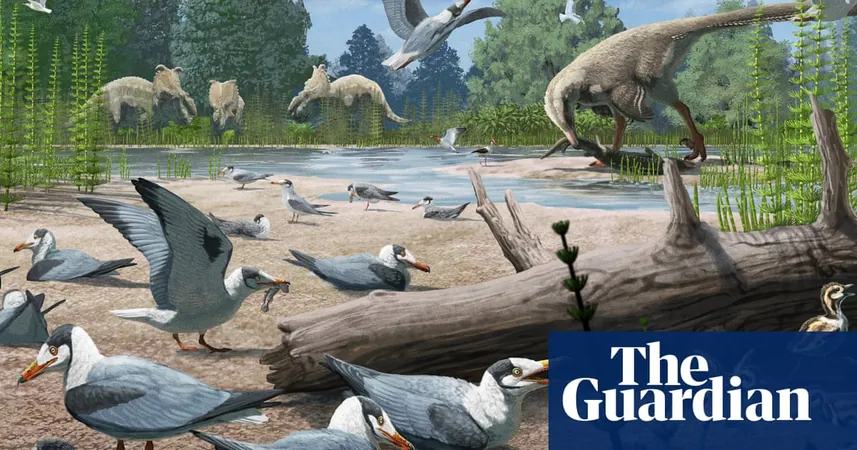
Shocking Discovery: Birds Nested in the Arctic During the Age of Dinosaurs!
2025-05-29
Author: Sarah
The Arctic: A Dinosaur Era Avian Paradise
Forget what you think you know about the Arctic being just a land of icy tundras and polar bears! Around 73 million years ago, this region was bustling with dinosaurs and, astonishingly, a variety of birds, as unveiled by recent fossil findings.
Unearthing the Oldest Evidence of Arctic Birds
Researchers at Princeton University have made a groundbreaking discovery: over 50 ancient bird fossils unearthed from Alaska's Prince Creek formation. This remarkable find pushes back the timeline for the oldest known evidence of birds nesting in polar climates by an incredible 25 million years!
Lauren Wilson, the lead author of the study, revealed that the previous record-holder for polar nesting was a penguin colony from Antarctica, dating back to about 46.5 million years ago. This new evidence dramatically shifts our understanding of avian history.
Birds: Crucial Players in Ancient Ecosystems
Today, more than 200 bird species live in the Arctic, playing vital ecological roles such as pollination and seed dispersal. This new discovery confirms that our feathered friends have long been an integral part of this frigid ecosystem.
Filling the Gaps in Bird Evolution
Professor Patrick Druckenmiller, co-author of the study, emphasized that these fossils are essential for understanding bird evolution. Despite the emergence of the earliest birds during the Late Jurassic period (about 150 million years ago), fossils of these delicate creatures are quite rare due to the fragility of their bones.
Historically, no bird fossils had been discovered in Alaska apart from a few footprints, making this find exceedingly rare.
The Quest for Fossils: A Challenge Worth Taking
The research team’s endeavor was no stroke of luck; it involved painstaking excavation and the meticulous washing and sieving of sandy deposits to unearth tiny fossils no larger than 2mm. Druckenmiller likened the experience to "panning for gold" — only their treasure was bird bones!
A Glimpse into Prehistoric Avian Life
The newly uncovered fossils indicate the presence of both hatchlings and embryos. Among them were birds from the now-extinct Ichthyornithes, resembling a toothed seagull, and Hesperornithes, ancient diving birds equipped with teeth.
Interestingly, many fossils belonged to toothless birds akin to modern-day ducks, hinting that these prehistoric creatures were closely related to today's avian populations.
Climate Conditions in the Ancient Arctic
Druckenmiller painted a vivid picture of the Prince Creek ecosystem 73 million years ago, describing a land with six months of relentless summer daylight, lush greenery, and plentiful food sources. Yet, winters, though milder than today's, would bring freezing temperatures and four months of relentless darkness.
A Potentially Migratory Avian Population
While the fossils suggest breedings in the Arctic, the researchers are unsure if these birds stayed year-round, with Wilson believing that some may have been migratory.
Unlocking the Secrets of Prehistoric Communities
Professor Steve Brusatte from the University of Edinburgh, who was not involved in the study, remarked on the significance of these tiny fossils. He concluded that they reveal birds as integral components of high-latitude ecosystems, challenging the notion that such communities are a recent phenomenon.
This remarkable discovery not only reshapes our understanding of bird evolution but also emphasizes the long-standing role birds have played in Earth’s diverse ecosystems!




 Brasil (PT)
Brasil (PT)
 Canada (EN)
Canada (EN)
 Chile (ES)
Chile (ES)
 Česko (CS)
Česko (CS)
 대한민국 (KO)
대한민국 (KO)
 España (ES)
España (ES)
 France (FR)
France (FR)
 Hong Kong (EN)
Hong Kong (EN)
 Italia (IT)
Italia (IT)
 日本 (JA)
日本 (JA)
 Magyarország (HU)
Magyarország (HU)
 Norge (NO)
Norge (NO)
 Polska (PL)
Polska (PL)
 Schweiz (DE)
Schweiz (DE)
 Singapore (EN)
Singapore (EN)
 Sverige (SV)
Sverige (SV)
 Suomi (FI)
Suomi (FI)
 Türkiye (TR)
Türkiye (TR)
 الإمارات العربية المتحدة (AR)
الإمارات العربية المتحدة (AR)